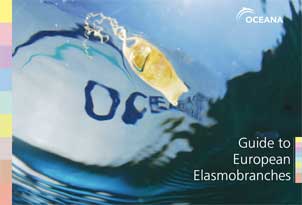Report | April 28, 2010
Guide to european elasmobranches
Elasmobranches, the group of fishes that include sharks and batoids (rays and other flat sharks), are found in all European waters, from the cold and deep waters of Greenland to the warm subtropical waters of the Canary Islands. Elasmobranches are cartilaginous fishes, meaning they have skeletons made of cartilage instead of bone; they present a wide diversity in shape, size, habitat, and reproduction methods. These species are highly adapted to the marine environment, with five to seven paired gill openings on both sides of the head for respiration and tiny tooth-like scales that improve hydrodynamics. Sharks typically present a cylindrical body shape and have thousands of teeth that are continually produced and shed over a lifetime. Batoids are much like flattened sharks, characterised by short bodies and two expanded pectoral fins that have an appearance similar to wings.
There are 136 species of elasmobranches that live in European waters (compared to 1,125 around the entire world); 56 of these species are rays, skates and other flat sharks. The elasmobranches in Europe are grouped into seven taxonomic orders: Lamniformes (mackerel sharks), Carcharhiniformes (ground sharks), Orectolobiformes (carpet sharks), Hexanchiformes (cow and frilled sharks), Squaliformes (dogfish sharks), Squatiniformes (angelsharks) and Rajiformes (rays and flat sharks). There are two additional extant order of elasmobranches not found in European waters: the Heterodontiformes (bullhead sharks) and Pristiophoriformes (sawsharks), which are mainly present in the Indian and Pacific oceans.
For the European elasmobranch populations assessed to date by the International Union for the Conservation of Nature (IUCN), the world’s most authoritative inventory on conservation statuses, one-third is threatened with extinction. The most endangered sharks in Europe are those targeted for industrial food production. For example, the porbeagle (Lamna nasus) and spurdog (Squalus acanthias), both highly valued in Europe for their meat and fins, are Critically Endangered in the Northeast Atlantic Ocean according to the IUCN Red List. Other species caught as by-catch are also suffering severe declines. The International Council for the Exploration for the Sea (ICES), the organisation responsible for providing scientific information on marine ecosystems to the European Union, has determined that the Critically Endangered angel shark (Squatina squatina) is now locally extinct in the North Sea and that the Endangered bottlenose skate (Rastroraja alba) is possibly extinct in the Celtic Seas.
In the Mediterranean, a sea with a long history of fishing, the proportion of threatened sharks and rays goes up to 42%, making this sea the most dangerous place on Earth for these animals according to the IUCN. In fact, several species of large predatory sharks in the Mediterranean, including the hammerhead (Sphyrna spp.) and thresher (Alopias vulpinus), have decreased over 97% relative to their abundances 200 years ago.
Sharks have been evolving and roaming the oceans for over 400 million years, but in an era marked by increased fisheries effort, improved technologies and rising market demand, their presence in Europe is being challenged by overfishing as targeted and accidental catch. Since sharks are extremely slow growing and produce few young, their populations are highly vulnerable to fisheries exploitation and can take decades to recover. Many sharks are top predators in the oceanic food web and declines in their populations threaten the structure and function of the marine environment with unpredictable consequences for other species.
Oceana is working to achieved improved fisheries management and conservation measures to safeguard the future of sharks in Europe. This guide gives an overview of the elasmobranch species that can be found in European waters, dividing them into the seven taxonomic orders present in this region. The habitat, European range, conservation status and management instruments in place for each species is detailed.


